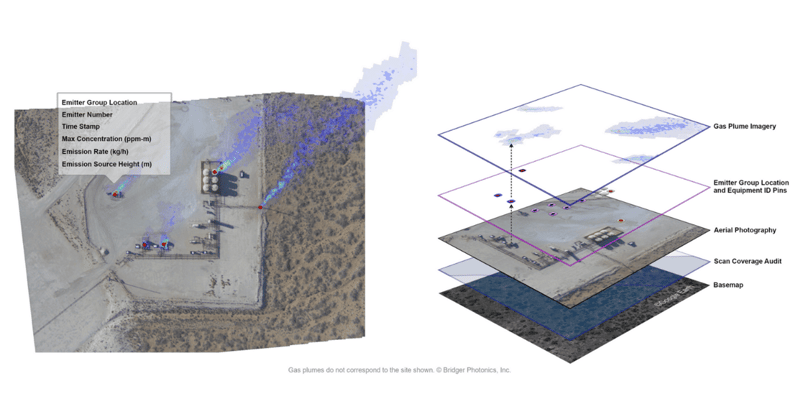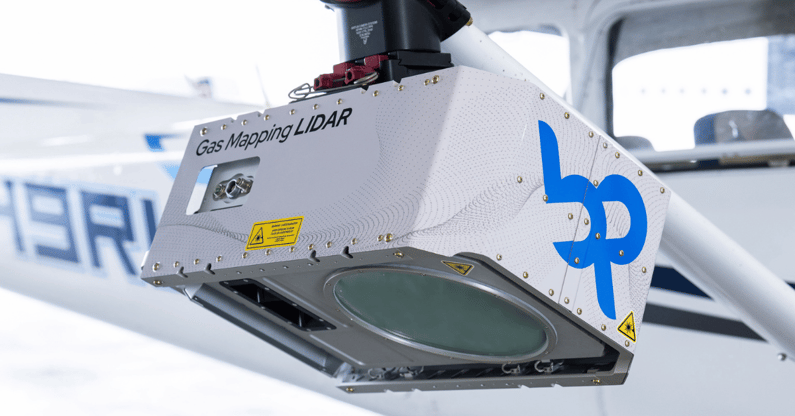Field-Proven Excellence for Aerial Methane Monitoring
At Bridger Photonics, our industry-leading aerial LiDAR technology detects, quantifies, and pinpoints methane emissions, providing accurate data tailored for effective leak detection and repair, and for strategic emissions management.
Bridger Photonics is committed to delivering unparalleled value for our clients. With best-in-class actionability, reliability, credibility, and flexibility, Bridger Photonics empowers organizations to optimize operational efficiency, track progress toward ESG goals, ensure regulatory compliance, and mitigate risk.
Let's dive deeper into four key aspects of our aerial LiDAR technology: actionability, reliability, flexibility, and credibility, and explore how these elements change the game for operators across all sectors of the oil and gas value chain.
1. Actionability: Pinpointing Emissions with Unprecedented Accuracy
As a client of Bridger Photonics, you can be confident that you know exactly where your emissions are—and just as importantly, where they are not.
Plume imagery, leak location maps, and equipment identification make it easy to go straight to the leak source. With us, there’s no need to send crews to sites where emissions aren’t present or to emissions that are actually coming from your neighbor's infrastructure. This means less windshield time and fewer wasted resources. This also protects against false super-emitter claims, since our sensors pinpoint every individual emission to within a ~2 meter (6 foot) radius, regardless of which sensitivity tier we scan at. This reduces the risk of aggregated plumes falsely indicating a super-emitter that is in fact not present.
Our leak rate quantification, or the size of the leak rates, gives you the data you need to prioritize repairs. And with virtually no false positives, there is no wild goose chase for emissions that don’t actually exist. This ability to detect emission sizes and specific locations accurately is only going to become more important as regulations change.
Fixing leaks is safer, more efficient, and more effective than ever before when you scan with aerial LiDAR. The unmatched data quality with precise leak locations, quantification of leak size, and aerial photography overlaid, means your crews are dialed in to the important details before they even arrive. They head for the right equipment, with the right tools, and the right approach to repair in mind.

GML technology also enables better strategic decision-making. By having an unprecedented breadth and depth of information about leak sources, locations, and sizes across an entire asset base, operators can systematically manage their assets. These datasets directly inform upgrades or retrofits. Plus, the intel allows operators to accurately baseline and track their emissions reductions, and monitor progress toward ESG goals.
With Bridger Photonics, your work is easily prioritized, you have an accurate understanding of the sources and magnitude of emissions, and you’ll have the answers you need to plan your emissions roadmap, both short and long term.
"This technology provides us with a critical early detection system that can help us mitigate leaks more quickly, while we also move to use more lower and zero-carbon fuels to increasingly decarbonize our pipeline system.”
-Gina Orozco, Vice President of Gas Engineering and System Integrity at SoCalGas
“Bridger’s Gas Mapping LiDAR™ scans our infrastructure from the air — using a laser attached to a small aircraft — helping to pinpoint leaking equipment and quantify the emissions rate. Using the data collected, we can address methane emissions more efficiently and comprehensively.”
2. Reliability: Scan in Nearly Any Condition
Bridger Photonics’ aerial LiDAR technology provides a level of reliability that competitors just can’t beat. This starts with our laser-based sensors that don’t rely on the angle of the sun, time of day, or temperature to operate. Bridger Photonics’ sensors operate in nearly any condition, so this means fewer down days. We can reliably scan more days of the year than any other aerial technology.
The LiDAR lasers within our sensors are an active light source—meaning they generate their own light to measure gas concentrations and distance. Because of that, we aren’t reliant on any external light source (e.g. the sun). Other aerial detection systems utilize solar infrared (IR) technology, which relies on the sun and is affected by the sun’s angle, cloud cover, shadows, rain, and time of day. While other technologies are affected by cold temperatures, our sensors are still out scanning in the field.
Efficient aerial deployment in nearly any condition can be conducted over entire asset bases in a matter of days. Scans can even be done across multiple sectors or types of facilities for operators who have assets in more than one part of the supply chain. Bridger’s technology can even be scaled among operators, as recently shown through the Appalachian Methane Initiative (AMI). This coalition-based approach is utilizing Bridger for widespread scanning across thousands of facilities for seven collaborative operators.
Across diverse sectors and assets, aerial LiDAR technology offers unmatched reliability, ensuring comprehensive coverage in nearly any condition. Our differentiated technology makes Bridger Photonics an especially capable partner to support you as you grow your emissions management program across more assets and with greater frequency.
“With the data provided, we’re able to more strategically and efficiently address our emissions and have a better understanding of our emissions inventory,”
“Technology approaches that can be used across multiple operators tend to be most cost-efficient at scale. Aircraft-based monitoring can group flights with nearby operators that have their own aerial detection programs.”
3. Credibility: Validated Technology and Industry Advocacy
As the established market leader in aerial methane detection, we’ve collaborated with many industry leaders to develop our data product, and we remain deeply engaged with the industry.
The methodology for our patented technology has been rigorously validated through third-party research and unparalleled scientific rigor. In fact, we have more than a dozen peer-reviewed scientific research papers to back it up. See them all on our Scientific Studies webpage.

We help companies prepare for both proactive and reactive decision making better than satellite, stationary, or OGI monitoring, at any size or scale. We deliver data that’s fully auditable and defensible, so your team can have complete peace of mind. Even in light of changing regulations, you’ve got the most comprehensive, trustworthy coverage with our sensors and our team.
Our team is deeply engaged in the world of methane emissions regulations for oil and gas. Our regulatory team has provided public comment letters on a number of regulations. We aim to ensure that emissions reduction is incentivized and operators aren’t overburdened.
Bridger Photonics leads the market with validated technology, offering auditable and defensible data for proactive emissions management, supported by ongoing industry engagement and advocacy for incentivized emissions reduction.
“ExxonMobil is deploying next-generation detection technologies under real-world operating conditions as part of our overall commitment to reduce methane emissions in our operations.”
-Bart Cahir, Senior Vice President of Unconventional, ExxonMobil
“… Alternative detection technologies will be a big part of our emission management strategy moving forward and will help us reduce emissions and achieve our climate and GHG targets.”
4. Flexibility: Tailoring Detection Sensitivity
Whether you’re focused on leak detection and repair, working to prevent super-emitters, or ready for strategic insights across all of your assets for systematic upgrades, Bridger’s aerial LiDAR data is your best solution.
The inherent flexibility of our program design means we can meet you wherever you are in your methane detection journey. We’re proud of having worked alongside industry in developing our standard, best-in-class emission rate detection sensitivity for the production and transmission sectors. But we tune our sensitivity based on your specific operator needs and goals, and we can meet any tier in EPA’s new OOOOb regulations. Regardless of which sensitivity you choose, our localization means that you can be confident that we accurately identify which emissions are from your assets, and which are from others, down to ~2 meters. Additionally, we parse out specific plumes from individual pieces of equipment rather than one large blob that could be seen as a super-emitter.
Bridger Photonics can offer a path to grow from less to more sensitive emissions detection over time without the hassle of changing vendors. While working with our team to develop the ideal scanning frequency and sensitivity combination, our recommendations are based on proven methodologies and rigorous ROI analysis.
We tune our detection sensitivity for specific applications, depending on sector and operator goals. Our best-in-class emission rate detection sensitivity options combined with minimal down days means that Bridger’s technology is truly unbeatable for granularity at scale.
"Their Gas Mapping LiDAR ™ excels in sensitivity, capturing more emissions and providing robust data products for methane leak detection in the natural gas value chain."
“It’s made a huge difference, in fact, it’s changed the way we work. GML has made it so that we can efficiently find emissions and eliminate them by repairing them as quickly as possible, but also strategize where we need to upgrade our system effectively.”
-Paul Espenan, Senior Vice President of EHS&R at Diversified Energy Company
Bridger Photonics: Your Partner in Aerial Methane Detection
Bridger Photonics' aerial LiDAR technology redefines methane detection, setting new standards for actionability, reliability, credibility, and flexibility. We enable oil and gas operators to monitor emissions with unprecedented accuracy, speed, and cost-effectiveness.
Start your journey today to make emissions reduction simple.

